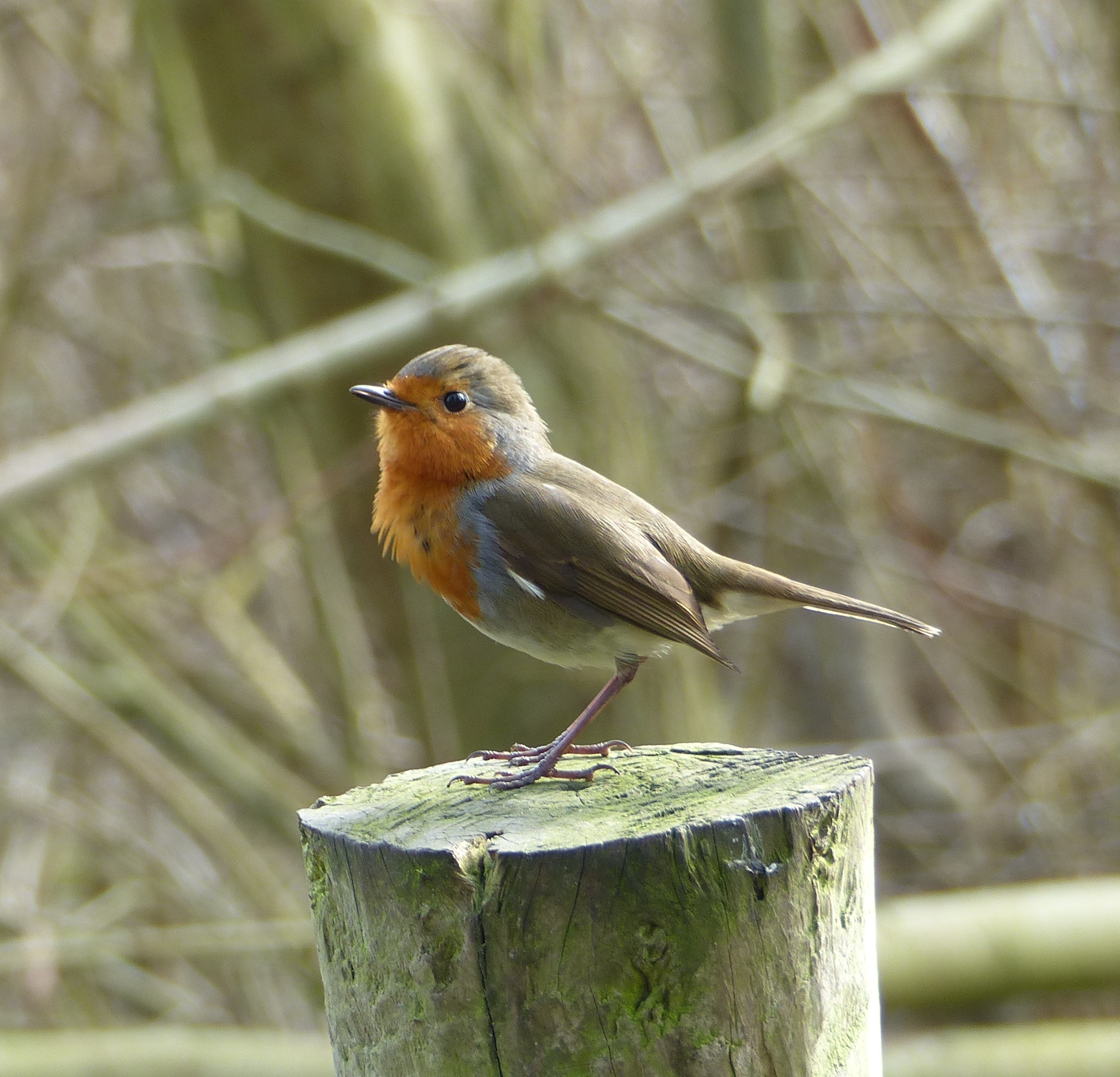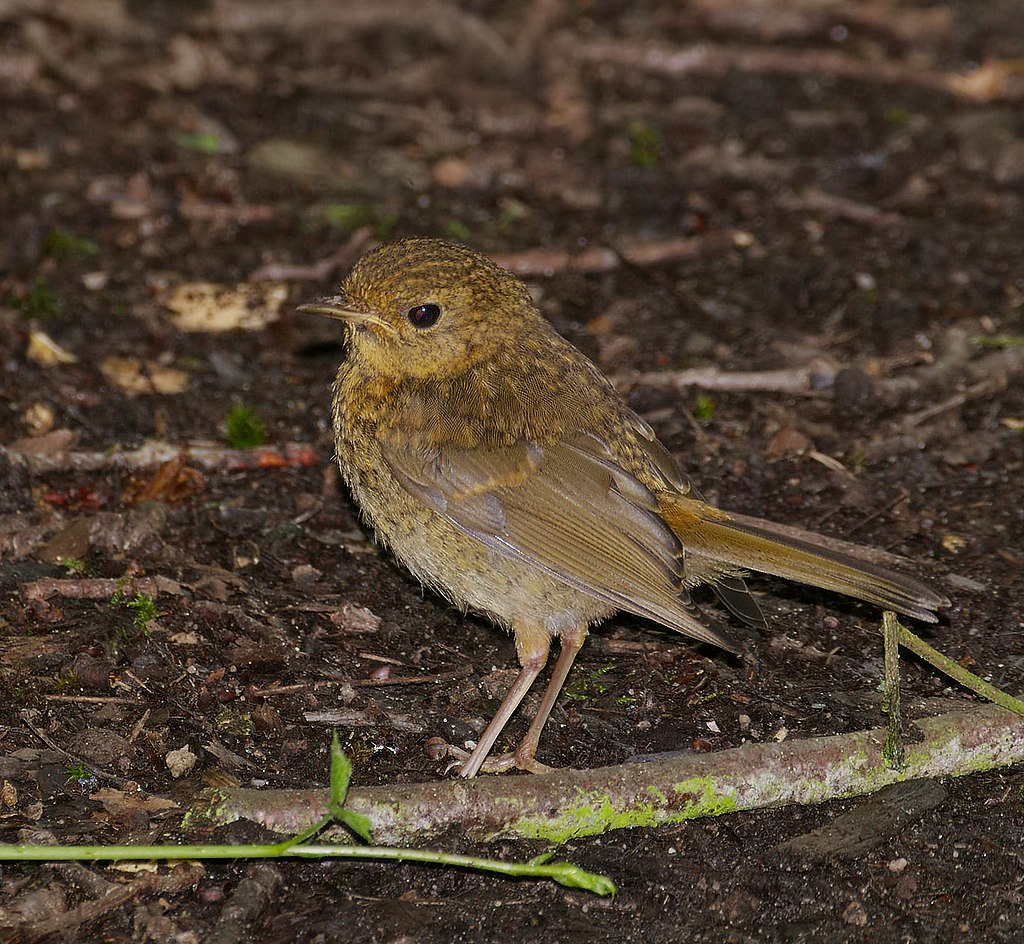Garden Wildlife
Garden Wildlife


What do they eat?
From the shape of its bill it is clear that the robin favours invertebrate food. I recall being very pleased to identity a silver wave moth in a birch tree in my garden, returning to the kitchen, and watching a robin eat the moth as it fluttered from branch to branch…it must have been watching. Likewise they regularly accompany me on the allotment when I am turning soil over and seem to like the smaller kinds of earthworm. Having said that, robins are opportunistic and will certainly take sunflower hearts, fats, peanuts and whatever else you put out as bird food.
Where do they breed?
Robins have two broods per year, between March and July, with up to 5 eggs in each. They nest on or near the ground in confined quiet spots which form a suitable cavity or in shrubs, sometimes holes in banks and stumps. These places include the pocket of a gardener's coat, boots and old kettles. They will use an open-fronted nest box.
What do they do?
These are probably the most obviously territorial birds in the garden. Robins like to sit on a prominent perch about 2.5 to 3.5m above the ground, where they keep an eye on other birds. They certainly react to other robins, sitting more upright with breast puffed out and tail cocked high, lifting their bill to reveal the full red throat and breast. They will actively chase off any other robins (apart from their mate) and indeed will go for other birds which vaguely resemble them in shape and size – eg dunnocks.
Robins were the archetypal bird for territorial studies in the 20th Century, and David Lack’s book ‘The Life of the Robin’ first published in the 1943 is a classic of natural history literature. Read Lack’s book and you will find watching robins becomes even more entertaining and interesting!
In winter British and Irish robins tend stay put near their breeding territories, with some moving south and west. Large numbers of Eurasian birds cross the North Sea and move through Britain before leaving for Southern Europe.
How are they doing?
The BTO Breeding Bird Survey for 2019 suggests a long term increase in robin numbers in the UK, although it seems to have levelled off in the last decade or so. At present there are thought to be 6 million territories.
Finding out more:
RSPB profile on robin
BTO profile on robin
Lack, David (1943 and later) The Life of the Robin. Various editions and publishers
Moss, Stephen (2017) The Robin: a Biography. Square Peg : Penguin Random House
Page written by Roy Smith, compiled by Steve Head
Robin Erithacus rubecula
One of the top four garden birds in terms of how often it is seen. The robin barely needs description in Britain and Ireland as it so ubiquitous in terms of imagery and culture – intimate associations with Christmas and winter in general. In 2015, it was voted the UK's "national bird" with more than a third of all votes - although this has no official status. In Britain and Ireland the robin is one of our tamest wild birds, frequently hanging around houses and gardens, and indeed gardeners, feeding opportunistically as we go about our work. This is not typical across the whole range of the robin as hunting and trapping of small wild birds has been commonplace elsewhere and the robin is much more wary over much of its range. Robins are a good example of a synanthropic species.
Like many garden birds, they are woodland species by nature but have successfully spread throughout a wide range of habitats in Britain and Ireland as humans have modified the environment.
Adult bird Juvenile
What do they look like?
The adult robin is unmistakeable, with its overall brown body, red face and breast, pale belly, pointed bill and cocked tail. It is about the same size (14 cm) as a house sparrow. If you use American sources at all, their so-called ‘robin’ is more like a blackbird with a red breast. Beware - uncritical editors sometimes get this wrong!
You often see juvenile robins in gardens during summer and autumn, and these are the same size and shape as adults but have pretty scalloped brownish marks on their dull breasts, and a more streaked look to their backs.
What do they sound like?
Robins sing for large part of the year. During spring and summer they advertise their breeding territory, and in autumn and winter both males and females set up their own feeding ranges and mark them with song.
The song itself is a lively and mellow suite of clear notes lasting several seconds. Here is a typical example
and two variants of a quiet ‘tick’ contact call which you might hear in a shrubbery.
Song Call Call


Alan Dalton, XC635685. Accessible at www.xeno-canto.org/635685.
Jorge Leitão, XC682189. Accessible at www.xeno-canto.org/682189.
Dominique Guillerme, XC696233. Accessible at www.xeno-canto.org/696233.
Robin Erithacus rubecula
One of the top four garden birds in terms of how often it is seen. The robin barely needs description in Britain and Ireland as it so ubiquitous in terms of imagery and culture – intimate associations with Christmas and winter in general. In 2015, it was voted the UK's "national bird" with more than a third of all votes - although this has no official status. In Britain and Ireland the robin is one of our tamest wild birds, frequently hanging around houses and gardens, and indeed gardeners, feeding opportunistically as we go about our work. This is not typical across the whole range of the robin as hunting and trapping of small wild birds has been commonplace elsewhere and the robin is much more wary over much of its range. Robins are a good example of a synanthropic species.
Like many garden birds, they are woodland species by nature but have successfully spread throughout a wide range of habitats in Britain and Ireland as humans have modified the environment.


Adult bird Juvenile
What do they look like?
The adult robin is unmistakeable, with its overall brown body, red face and breast, pale belly, pointed bill and cocked tail. It is about the same size (14 cm) as a house sparrow. If you use American sources at all, their so-called ‘robin’ is more like a blackbird with a red breast. Beware - uncritical editors sometimes get this wrong!
You often see juvenile robins in gardens during summer and autumn, and these are the same size and shape as adults but have pretty scalloped brownish marks on their dull breasts, and a more streaked look to their backs.
What do they sound like?
Robins sing for large part of the year. During spring and summer they advertise their breeding territory, and in autumn and winter both males and females set up their own feeding ranges and mark them with song.
The song itself is a lively and mellow suite of clear notes lasting several seconds. Here is a typical example and two variants of a quiet ‘tick’ contact call which you might hear in a shrubbery.
Song Call Call
What do they eat?
From the shape of its bill it is clear that the robin favours invertebrate food. I recall being very pleased to identity a silver wave moth in a birch tree in my garden, returning to the kitchen, and watching a robin eat the moth as it fluttered from branch to branch…it must have been watching. Likewise they regularly accompany me on the allotment when I am turning soil over and seem to like the smaller kinds of earthworm. Having said that, robins are opportunistic and will certainly take sunflower hearts, fats, peanuts and whatever else you put out as bird food.
Where do they breed?
Robins have two broods per year, between March and July, with up to 5 eggs in each. They nest on or near the ground in confined quiet spots which form a suitable cavity or in shrubs, sometimes holes in banks and stumps. These places include the pocket of a gardener's coat, boots and old kettles. They will use an open-fronted nest box.
What do they do?
These are probably the most obviously territorial birds in the garden. Robins like to sit on a prominent perch about 2.5 to 3.5m above the ground, where they keep an eye on other birds. They certainly react to other robins, sitting more upright with breast puffed out and tail cocked high, lifting their bill to reveal the full red throat and breast. They will actively chase off any other robins (apart from their mate) and indeed will go for other birds which vaguely resemble them in shape and size – eg dunnocks.
Robins were the archetypal bird for territorial studies in the 20th Century, and David Lack’s book ‘The Life of the Robin’ first published in the 1943 is a classic of natural history literature. Read Lack’s book and you will find watching robins becomes even more entertaining and interesting!
In winter British and Irish robins tend stay put near their breeding territories, with some moving south and west. Large numbers of Eurasian birds cross the North Sea and move through Britain before leaving for Southern Europe.
How are they doing?
The BTO Breeding Bird Survey for 2019 suggests a long term increase in robin numbers in the UK, although it seems to have levelled off in the last decade or so. At present there are thought to be 6 million territories.
Finding out more:
Lack, David (1943 and later) The Life of the Robin. Various editions and publishers
Moss, Stephen (2017) The Robin: a Biography. Square Peg : Penguin Random House
Page written by Roy Smith, compiled by Steve Head
























